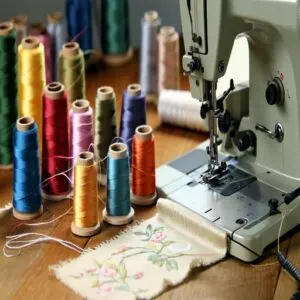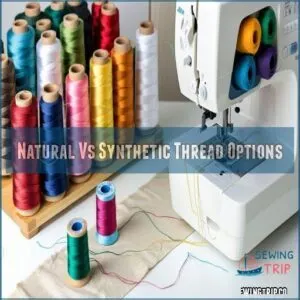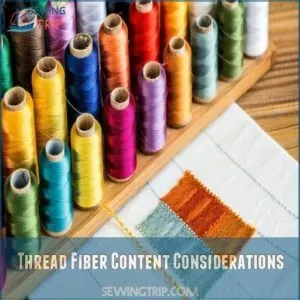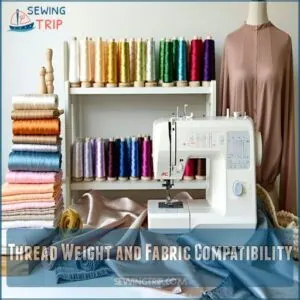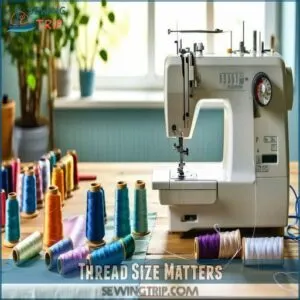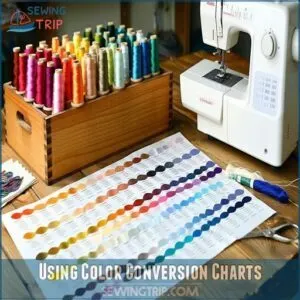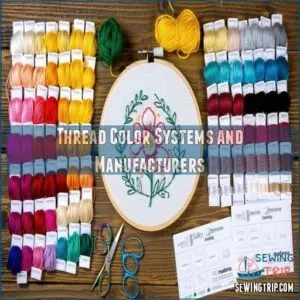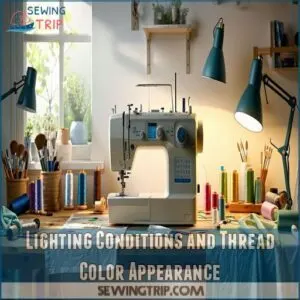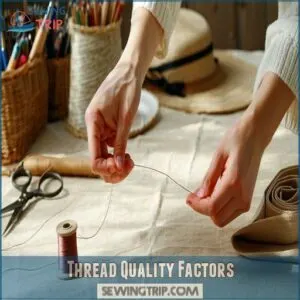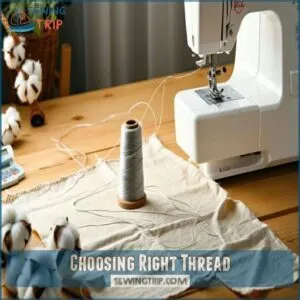This site is supported by our readers. We may earn a commission, at no cost to you, if you purchase through links.
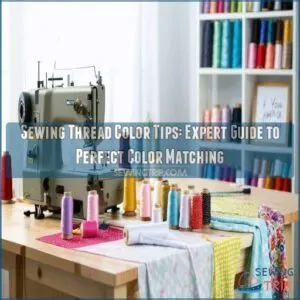
When working with prints, pick your thread based on the dominant color. Don’t forget to keep your thread color consistent throughout – nobody wants a patchwork of different shades!
Match your thread type to your fabric weight too – delicate fabrics need fine threads, while heavy-duty projects require stronger options. There’s an art to selecting the perfect thread weight that’ll make your stitches sing and your seams stay strong.
Table Of Contents
Key Takeaways
- Match your thread to your fabric, using a shade slightly darker for invisible seams or the dominant color in prints for a cohesive look.
- Test thread colors under natural light to ensure accuracy, as artificial lighting can distort hues.
- Pair thread type and weight with your fabric’s weight and texture for strong, professional-looking stitches.
- Stick to consistent thread colors across your project and store spools away from direct sunlight to prevent fading.
Thread Color Selection
Just like choosing the perfect accessory for an outfit, selecting the right thread color can make or break your sewing project.
Whether you’re working with solid fabrics or bold patterns, you’ll want to match your thread color to your fabric.
For invisible seams, look at your fabric under natural light and choose a thread shade slightly darker than your material.
Choosing Thread Color for Fabric
Finding the perfect thread color for your fabric can be challenging. Understanding thread color matching is important for achieving professional-looking results.
For most projects, aim for a close match – try holding the thread against your fabric in natural light.
When working with prints, choose the dominant color as your guide. For testing thread choices, pull a strand across your fabric to check the visual impact.
Matching Thread With Fabric Pattern
Now that you’ve got your fabric picked out, let’s tackle those patterns.
When matching thread fabric, consider both the print scale and pattern complexity.
For abstract designs like geometrics, you’ve got more wiggle room with thread color matching.
But for concrete patterns like florals, stick to the dominant color or secondary hues that complement your design.
Thread blending works best when you match the pattern’s flow and direction.
Considerations for Thread Color Consistency
Beyond fabric patterns, maintaining thread color consistency across your entire project can be tricky. Light changes throughout the day affect how colors appear, leading to unexpected hue shifts in your final piece.
Here’s what to watch for when checking thread color matching:
- Different dye lots can show slight color variance, even within the same brand
- Natural daylight reveals true thread colors better than artificial lighting
- Store lighting often masks subtle tint matching differences
- Thread colorfastness varies between manufacturers and fiber types
- Your thread color chart might look different at home than in the store
Thread Type Importance
You’ll need more than just the right color to make your sewing project look professional – choosing the correct thread type is equally important for strength and durability.
Whether you’re working with delicate silk or sturdy denim, matching your thread’s fiber content and weight to your fabric will make all the difference in your finished piece.
Natural Vs Synthetic Thread Options
Choosing between natural threads and synthetic threads often comes down to your project’s needs. Natural fibers like cotton threads offer excellent breathability and eco-friendly options, while synthetic alternatives like polyester threads provide superior fabric durability.
For thread color matching, natural threads give you earthy tones, but synthetic threads offer more vibrant colors.
Understanding the thread types comparison is important in making an informed decision about the thread that best suits your project.
Consider thread blends that combine the best of both: the strength of synthetics with the comfort of natural fibers.
Thread Fiber Content Considerations
When selecting cotton thread for specific projects, consider the intended use and fabric type to guarantee satisfactory results. Your thread fiber choice can make or break your project’s success.
You’ll notice significant differences in thread fiber performance when matching various fabrics. Natural and synthetic options each bring unique characteristics to your projects.
Here’s what matters most:
- Cotton thread offers superior breathability and comfort, perfect for natural fabrics like linen
- Polyester thread delivers outstanding durability and colorfastness for everyday wear
- Silk thread provides exceptional fabric compatibility with delicate materials
Thread Weight and Fabric Compatibility
Throughout your sewing journey, matching thread weight to fabric type makes the difference between professional results and amateur mistakes.
Here’s a quick guide to help you nail the perfect combination:
| Fabric Type | Thread Weight | Tension Balance | Best Uses |
|---|---|---|---|
| Delicate | Fine (60-70) |
Thread Size Matters
Just like you need the right shoe size for your feet, you’ll need the right thread size for your fabric – it’s not just about color matching.
Whether you’re working with delicate silk or sturdy denim, choosing the correct thread weight guarantees your stitches look professional and hold up well over time.
Selecting Thread Size for Fabric Type
Selecting the right thread size directly impacts your project’s seam strength and stitch appearance.
For lightweight fabrics like silk or chiffon, opt for fine 60-weight thread to prevent fabric damage.
Medium-weight cottons work best with standard 50-weight thread, while heavy fabrics like denim or canvas require sturdy 30-weight thread.
Match thread weight to fabric weight for ideal project durability.
Thread Size and Sewing Machine Compatibility
Your sewing machine’s happiness depends on matching thread size to its capabilities. Different machines handle varying thread weights differently, so check your manual for specific recommendations.
Understanding the thread types is essential for achieving the best results.
When using thicker threads, you’ll need to adjust the tension and choose larger needle sizes to prevent thread breakage.
Remember, the right combination of thread weight, stitch length, and bobbin thread guarantees smooth, professional results.
Thread Size and Project Requirements
Now that you’ve got your machine settings dialed in, let’s match your thread size to what you’re making. Thread weight impacts more than just how it runs through your machine:
- Heavy upholstery projects need sturdy thread (size 30-40) for lasting seam strength
- Delicate silk blouses call for fine thread (size 60-100) for elegant stitch appearance
- Quilting requires medium-weight thread (size 40-50) to hold layers together without bulk
Color Matching Techniques
You’ll need more than just your eye to match thread colors perfectly, as lighting conditions and fabric patterns can trick even experienced sewists.
Let’s explore the essential techniques you’ll use to select the right thread color every time, from using conversion charts to understanding how different lighting affects color appearance.
Using Color Conversion Charts
Color conversion charts act as your trusty translator between different thread brands, helping you nail that perfect match every time.
When you’re working with a Pantone reference or switching between manufacturers, these charts map out equivalent colors across brands.
Digital charts offer quick lookups, while printed thread color charts let you physically compare colors, and keep in mind that chart accuracy might vary depending on your screen’s settings and the use of thread color charts.
Thread Color Systems and Manufacturers
Major thread brands like Sulky and Gutermann each use their own color codes, which can feel like learning different languages. The Pantone system acts as your universal translator, helping match colors across manufacturers.
Understanding a thread color matching guide is essential for achieving professional-looking embroidery results.
You’ll find color charts and manufacturer guides from companies like Bernina and Madeira invaluable for thread color matching. These standardized systems guarantee your embroidery projects maintain consistent colors, regardless of which brand you choose.
Lighting Conditions and Thread Color Appearance
After getting cozy with thread manufacturer codes, you’ll want to tackle lighting’s sneaky impact on thread color appearance.
Here’s what every sewist learns the hard way about light temperature influence:
- Natural light shows the truest colors, especially between 10 AM and 2 PM
- LED bulbs can make threads appear cooler
- Fluorescent lighting often adds a greenish cast
- Incandescent bulbs warm up thread tones
- Mixed lighting challenges create metamerism issues, where colors match in one light but clash in another
Thread Quality Factors
You’ll want to check your thread’s quality before starting any sewing project, as poor-quality thread can lead to broken seams and machine problems.
When you’re testing thread quality, look for smoothness and strength by gently pulling a length between your hands, and avoid any thread that feels rough or breaks easily.
Thread Strength and Durability
Choosing the best thread is essential for the longevity of your sewing projects. When selecting thread for your project, thread strength becomes your best ally against material fatigue and unexpected thread breakage.
Fiber resilience varies considerably. Polyester offers superior tensile testing results compared to cotton, while nylon excels in fraying resistance.
For demanding projects, opt for heavy-duty thread with higher thread weight. Remember, proper thread color selection shouldn’t compromise durability – quality threads maintain strength regardless of shade.
Thread Smoothness and Abrasion Resistance
While thread strength matters, smooth-running thread can make or break your sewing experience. Look for sewing thread with excellent friction reduction and snag resistance – it’ll glide through your fabric like butter.
- Run the thread between your fingers – quality thread feels silky, not rough
- Check for consistent surface texture without fuzzy bits
- Test thread durability by giving it a quick tug
- Examine thread fiber consistency in good lighting
- Watch for loose fibers that could cause abrasion effects
Want to save yourself headaches? Poor-quality thread types can leave you with a machine full of lint and plenty of frustration. That’s why taking a moment to assess thread quality before starting your project pays off big time.
Thread Elasticity and Stretchiness
For the best results, you’ll need to match your thread’s stretch tolerance with your fabric type.
Different thread fiber compositions offer varying elasticity types and recovery properties.
For stretchy fabrics, look for thread elongation ratings that complement your material’s movement. Elastic thread works great for shirring, while standard sewing thread types provide enough give for most knits without compromising seam strength.
Choosing Right Thread
Picking the right thread isn’t just about matching colors to your fabric. Factors like weight, fiber content, and project type play equally important roles in your sewing success.
Whether you’re working with delicate silk or sturdy denim, you’ll need to evaluate both the thread’s strength and its compatibility with your fabric to achieve professional-looking results.
Reputable Thread Brands and Quality
Now that you know what makes quality thread, let’s look at trusted brands. Brand recognition isn’t just about fancy names – it’s about consistent performance.
Here’s what experienced sewists look for:
- Juki offers industrial-strength threads perfect for heavy-duty projects
- SINGER maintains high quality standards across their thread lines
- Brother threads work smoothly in most machines, reducing snags
- Pfaff delivers reliable performance with excellent color retention
When evaluating threads, consider the thread quality standards of reputable manufacturers. Test threads by gently pulling – quality threads shouldn’t snap easily or feel rough.
Thread Weight and Fabric Suitability
When matching thread weight to fabric thickness, think of it like pairing dance partners – they need to move well together.
Light fabrics call for finer thread density (50-60 weight), while heavy materials demand stronger thread weight (30-40).
Understanding thread types is essential for making informed decisions about thread weight and fiber.
Your sewing performance depends on this balance.
Check the weave patterns and material strength of your fabric to determine the perfect thread fiber match for ideal fabric compatibility.
Project Type and Thread Requirements
For perfect thread requirements, match your thread to both your project type and fabric needs. Your thread choice impacts everything from thread tension to sewing speed.
Here’s what impacts your thread color selection:
- Delicate lingerie needs fine, matching threads
- Upholstery demands heavy-duty, contrasting stitches
- Quilting requires specialized cotton threads
- Denim projects need strong topstitching threads
- Stretchy fabrics demand flexible polyester threads
Consider your project scope and material selection carefully – they’ll determine your success.
Frequently Asked Questions (FAQs)
How to choose thread color for sewing?
Choose thread one shade darker than your fabric for ideal seams.
Test colors in natural light, matching thread to fabric’s dominant tone.
If unsure, opt for a slightly darker shade – it’ll blend better.
Should thread be lighter or darker than fabric?
Like a shadow following light, go slightly darker than your fabric for a polished look.
You’ll want thread that’s a shade deeper to create clean, invisible seams that blend seamlessly into your project.
How would you choose the appropriate color of the thread?
You’ll want to match your fabric color, but go one shade darker for topstitching visibility.
For seams that shouldn’t show, pick a slightly lighter shade that blends naturally with your material.
What happens if you use a different color thread and bobbin?
Using different colors for the thread and bobbin creates visible stitches on one side, giving a contrasting or mismatched look.
It’s fine for decorative effects but might stand out unintentionally in regular sewing projects.
Can direct sunlight affect thread color over time?
Think of thread colors as vibrant paintings—the sun’s rays can fade those hues over time.
Direct sunlight saps thread color vibrancy, leaving it dull and lifeless.
Protect spools by storing them away from light.
How do neon and metallic threads behave differently?
Neon threads pop with vivid brightness but can feel slippery and tricky to handle, while metallic threads bring shimmer and shine but often fray or break.
Use high-quality thread and slower stitching for smoother results.
Should bobbin thread match top thread color?
Match your bobbin thread to the top thread color for visible stitching.
Use neutral bobbin shades like white or gray for hidden seams. It’s all about balancing look and practicality, so choose based on visibility.
When to use variegated versus solid color threads?
Use variegated thread for decorative projects when you want bold, eye-catching effects or texture.
Stick to solid threads for clean, uniform stitches. Variegated adds flair; solid keeps it classic and straightforward.
It’s all about style!
Do thread colors look different between manufacturers?
Yes, thread colors can vary between manufacturers because each uses unique dye formulas and color systems.
A red from one brand might’ve different undertones than another.
Always compare swatches when switching brands.
Conclusion
Imagine you’re sewing a navy dress, and choosing a slightly darker navy thread results in flawless, nearly invisible seams.
That’s the magic of nailing thread color selection! Whether it’s matching thread to fabric patterns, considering lighting, or balancing thread type with fabric weight, these sewing thread color tips have you covered.
Stick with consistent colors and trusted thread brands to guarantee strong, polished seams every time. Your stitches deserve the perfect match—with these tips, you’re ready to create seamlessly!

